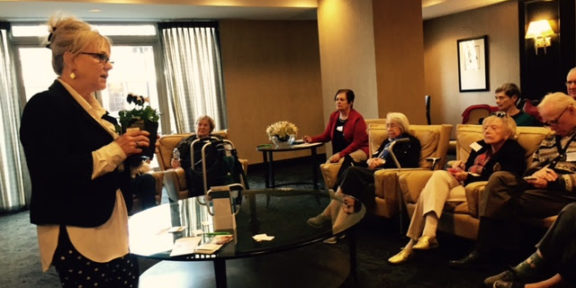From the outside, Yes! Organic Market appears to be like any other food store in the middle of a block. It’s not that big, the small sign doesn’t stand out and there are no open doors or carts of fresh produce outside to lure people in.
Nevertheless, the Yes! Organic Market in Cleveland Park may very well be the most convenient and beneficial market in the area. If on any given day, a Cleveland Park resident decided to go on a diet or live healthier, he or she would more than likely be able to find whatever fruits or vegetables they need right across the street or close by.
Wards 2 and 3, where Cleveland Park is located, are considered areas with “food security,” having higher incomes and greater access to supermarkets, specialty grocery stores and other sources of fresh produce, according to D.C. Hunger Solutions. Their neighborhoods have been described as food oases, rather than food deserts often found in Wards 7 and 8 where many residents must hunt to find fresh fruits and vegetables.
Located on the 3400 block of Connecticut Avenue are two supermarkets, neither of them part of a major chain. Yes! Organic Market and Brookeville Supermarket provide a convenience for Cleveland Park residents that is absent in low-income communities. Both stores provide a wide variety of fresh fruits and vegetables, some that you might not find at a local Giant or Safeway. Yes! Organic Market is considerably smaller than Brookville, but still provides local residents with pretty much anything that is on their shopping list.
“I probably come here two to three times a week,” said Steve Lambert, a Cleveland Park resident. “After work, I usually pick up whatever my wife and I are going to eat for the night.”
As he browsed through the vegetables, Lambert said that the organic market is especially helpful to people like him who make an effort to eat healthy. “It’s nice to have a market that caters to more of a organic and healthy style of living. It’s definitely convenient for me.”
Upon walking in the organic market, one will find fresh cilantro, flat leaf parsley, organic bok choy, leeks, oranges, Bartlett pears and more. The dairy section provides more than 10 brands of yogurt and six-plus brands of both organic and soy milk.
Standing next to the dairy products is David B. He lives in the neighborhood and comes in the store practically every day after work to find a meal, preferably an Asian meal that has already been prepared. He’s a vegetarian so the organic market is convenient in more ways than one.
“Being a vegetarian in the city isn’t the easiest thing, but this store helps out a lot,” he said. “I buy the same thing pretty much over and over, because it’s better for my health.” Kiwi, tofu and salad are a few regular items on his list.
Giant, he says, has almost none of the vegetarian products that he purchases.
Differences in Quality and Quantity
Another area resident, Dara Walsh prefers Yes! Organic and Brookeville over Giant, which is only four blocks away from where she lives. Although Walsh is a graduate student, she does not mind the steeper prices because of the quality of food that the two markets offer.
Walsh is studying nutrition and says she has seen through research the difference of quality and quantity of fresh meat, fruit and vegetables that are placed in different areas around Washington.
“Certain supermarkets will have a larger variety of foods and others won’t because of the area,” she said.
Large supermarkets like Giant and Safeway appear to be the same in every ward, however, the produce sections vary in size and quality in different areas of the district. The produce sections at the Giant in the Van Ness area of Ward 3 is twice as big as the one in Giant at 7th and O Street in Ward 1.
In an obesity report issued earlier this month, the District of Columbia reported that the average income in Ward 3 was $128,000, $99,000 more than Ward 8, which has the lowest income at $29,000. Ward 3 also ranks as the largest, therefore the availability of space and potential of a small market’s success is much greater.
Unlike residents in low-income wards, Ward 3 residents don’t have a problem finding adequate amounts of quality produce. Of the six Yes! Organic Markets that are open in Washington, two are located in Petworth and Anacostia, where affordability of high-quality produce is an issue for many residents. A number of Ward 3 residents stop by the local markets multiple times a week.
Grocery Shopping: ‘A Task Without a Vehicle’
Gail Powell, a single mother of two in Petworth, says when she goes shopping it definitely isn’t everyday.
“I can’t afford to go shopping several times a week,” said Powell, who is currently unemployed. “When I do go to Giant or Safeway, I make sure I get stuff that can last through the week or month.”
Powell doesn’t live within short walking distance of Giant, Safeway or the organic market in Petworth.
“Going grocery shopping period is a task without a vehicle,” she said. “Usually my sister or somebody will take me.”
Like Powell, many Ward 1 residents buy what they can afford. Therefore, another question arises. Are residents of low-income wards even concerned with buying fresh produce?
“Of course, I am concerned with my own and my kids’ health,” Powell said. “But sometimes when I go to the grocery store, it’s hard to find a good deal. I can’t always get lots of fruit and vegetables for a bargain.”
“I may want to buy grapefruit or a mixed bag of apples and oranges, but they aren’t always the freshest — at least they don’t appear to be. If there was a farmers’ market around where fruit and stuff is a little cheaper, I wouldn’t mind going there.”
For this reason, Howard University Hospital, located south of Petworth on Georgia Avenue, opened a farmers’ market in its courtyard this week. Around the corner is one of the few urban gardens located in the district’s food deserts, Common Good City Farm on V Street between Second and Fourth Streets.
Fresh Food Straight From the Farm
Palisades resident Barbara Elsas had the same thought as Powell about finding fresh fruits and vegetables. Although Elsas lives in Ward 3, where the selection of produce is visibly better than areas where Powell lives, she wanted to ensure that the produce she was buying came straight from the farm.
Elsas and other volunteers worked with the Palisades Neighborhood Citizens Association to get the farmers’ market up and running. The Palisades farmers’ market is open almost every Sunday.
“I helped to set up this market and found several of the farmers,” said Elsas, now the market manager. “My personal motivation is wanting to eat seasonally and eat food that is grown locally. I want to buy and eat food from the farmer who grew it.”
All of the farms are inspected to ensure that their food is locally grown and that they are not using unlawful pesticides.
“I don’t know who grew the food in a supermarket or what they put on it or how long it took to get here,” Elsas said. “I just want to support all of our local farms and farmers to keep them in business.”
Elsas says she is aware that she lives in an area where people often buy fresh food, but it is hard at times getting Ward 3 residents to buy locally grown produce.
Matias Fernaudez visits the farmers’ market in Dupont Circle from time to time, but prefers the organic and smaller supermarkets near his home because of the convenience.
Surprise Over Food Deserts
Fernaudez, like other shoppers in the area, was surprised that food deserts even existed in Washington.
“It seems like a logical place to go to if you’re a grocery store,” he said, speaking of smaller markets making the move to low-income areas. “You got a lot of willing customers. If you want to open a store, a food desert seems like the obvious place to go to.”
Kelly Downs, another Ward 3 resident, believes that organic and small supermarkets should be open to populating low-income areas just as they do in Ward 3, but only under one condition.
“If stores like these can keep cost down and make it easier for low-income people to eat well, then definitely,” Downs said. “I don’t know if a store is really going to help if it’s still expensive.”
For low-income residents who would just like to see a bigger selection and better quality fruits and vegetables in Giant and Safeway, Downs has a suggestion.
“The selection in Petworth is definitely smaller, but If large supermarkets care to contribute to people being able to eat well, I think they should at least try to broaden the variety,” Downs says.
From a business perspective, it makes sense to place costly food stores where people can and are willing to buy it. However, when it comes to affordable, healthy food, everyone high and low-income needs it, experts and residents throughout the district say. They wonder how long will accessibility and affordability remain an issue for residents outside Ward 3?
David B says that if the smaller supermarkets and Yes! Organic were not as accessible, he doesn’t know what he would do.
In regards to people who live in food deserts he says, “It’s unfair, because they have fewer choices and have to use a lot of energy to get to food. We have it so much easier.”
Makula Dunbar is a correspondent for the Howard University News Service. She also created the opening video for the food desert series.



